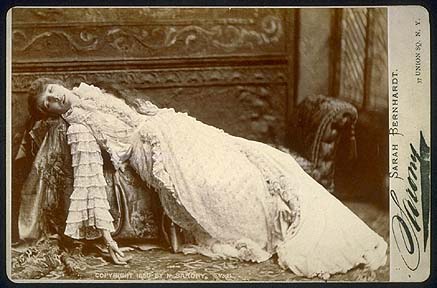|
PUBLISH OR PERISH
by Marianne Fulton
|

|
To create and enhance the career of stars, entertainers, or
celebrities, to market their particular persona to the widest audience,
publishing has always been the vital ingredient in the making and even
survival of the individualís livelihood. The combination of image
dissemination and the publicís urge to possess or identify with a particular
individual means that the picture must be seen, must be attainable.
For a celebrity to be photographed at all, there must be a public demand,
a desire on the part of the sitter to be portrayed by a distinguished photographer
or a clever agent who sees the uses and power of photography. This has
been true since the time of the daguerreotype--steel-line engravings of
Abraham Lincoln or "the Swedish Nightingale," Jenny Lind, for example,
were reproduced in the thousands by publishing companies and newspapers.
 Here
are two early examples of celebrities taking advantage of photography and,
as always, vice versa. The first is a multiple portrait is of Madame
Petipa (ca. 1863, an uncut carte-de-visite on albumin paper), Russian
ballerina and wife of the revered French choreographer of the Russian Ballet,
Marius Petipa. (He was famous for some 50 different ballets including
Swan Lake ). MariePetipa was famous throughout Europe
in her own right for her character roles in ballet such as The Little
Moujik. Here we have the confluence of celebrated artistry and
the popular photographer, André Adolphe Disdéri. By
looking at the serial portraits, made in a specially designed camera of
eight lenses, we see that this is not high art in the making, but a simple
commercial set-up made for easy variation and selection. Each is
a small image (about 4" x 2 1/2") that would be cut and mounted on a slightly
larger board bearing Disdériís name and sold to the public.
Here
are two early examples of celebrities taking advantage of photography and,
as always, vice versa. The first is a multiple portrait is of Madame
Petipa (ca. 1863, an uncut carte-de-visite on albumin paper), Russian
ballerina and wife of the revered French choreographer of the Russian Ballet,
Marius Petipa. (He was famous for some 50 different ballets including
Swan Lake ). MariePetipa was famous throughout Europe
in her own right for her character roles in ballet such as The Little
Moujik. Here we have the confluence of celebrated artistry and
the popular photographer, André Adolphe Disdéri. By
looking at the serial portraits, made in a specially designed camera of
eight lenses, we see that this is not high art in the making, but a simple
commercial set-up made for easy variation and selection. Each is
a small image (about 4" x 2 1/2") that would be cut and mounted on a slightly
larger board bearing Disdériís name and sold to the public.
Disdéri is said to have invented the inexpensive carte-de-visite
format which he patented in 1854. It quickly caught on in an age of formal
afternoons complete with calling cards left in a silver tray by the door.
As the photographer Nadar wrote, Disdéri "created a veritable fad
which immediately infatuated the entire world..." and by doing so he popularized
photography, "by giving infinitely more for infinitely less."
 In
the second portrait, the great French actress, Sarah Bernhardt (ca. 1880,
an albumin print cabinet card), no doubt re-enacting the death scene from
the play, La Dame aux Camélias is draped across one of the
many props kept in the New York studio of Napoleon Sarony. Sarony
utilized the next and larger form of card photograph--the cabinet card
(5 1/2" x 4"). These cards, usually vertical, were also sold to an adoring
international public. This distribution of cards, whatever size, was a
form of publishing that gave the sitters a much larger audience than they
could ever have achieved in the limiting venue of the playhouse. (Remember
these images were made just before commercial halftone reproduction was
possible.) By the end of his career, Sarony is said to have accumulated
40,000 negatives of celebrities.
In
the second portrait, the great French actress, Sarah Bernhardt (ca. 1880,
an albumin print cabinet card), no doubt re-enacting the death scene from
the play, La Dame aux Camélias is draped across one of the
many props kept in the New York studio of Napoleon Sarony. Sarony
utilized the next and larger form of card photograph--the cabinet card
(5 1/2" x 4"). These cards, usually vertical, were also sold to an adoring
international public. This distribution of cards, whatever size, was a
form of publishing that gave the sitters a much larger audience than they
could ever have achieved in the limiting venue of the playhouse. (Remember
these images were made just before commercial halftone reproduction was
possible.) By the end of his career, Sarony is said to have accumulated
40,000 negatives of celebrities.
No home was complete without an album, possibly of fine leather with gold-embossed
design, that held the card portraits of family and friends. Often
the beginning pages would assert the ownerís allegiance and patriotism
with an image of the Lincoln, Queen Victoria, General Grant or General
Lee. Celebrities were also envied additions and collected rather like that
societyís version of baseball cards. Through public need and excellent
marketing, Disdéri and others brought the famous into the home.
Throughout the decades there have been individuals who momentarily captured
a celebrated figure. Some did it with more panache, skill, and artistry
than others.
In the twenties and thirties of this century in America, Nickolas Muray,
George Hurrell, and Edward Steichen were three of the most famous photographers
working. While Muray is better known for his fabulously rich 4-color carbro
prints of commercial products, in the twenties, many modern dancers, actors
and writers went to his studio. In his unpublished notes referring to this
time, Muray thoughtfully describes his approach:
| "Though most of my pictures were
made of professionals--I mean professionals in one sense or another--stage,
writing, or magazine people...--my job was to put them at ease in a friendly
atmosphere....Not only must [the photographer] please the sitter but
the sitterís family and also [fulfill] the purpose for which the picture
was taken. Much of this knowledge was accumulated by practicing and
employing a point of view that will accomplish results--without it [photography]
becomes merely copying a personís outward physiognomy without including
in the picture the mood, the character, the intelligence, the beauty, and
affectionate front which is known to friends, the family... the publisher,
manager, and the editor who gives you assignments." |
His syntax, though casual, reveals much: though his work portrayed
the famous, he still sought to find something unique and personal in each
individual; this uniqueness may have consisted of the character the sitter
wished to impress on the public; it certainly had everything to do with
what those paying for the portrait expected.
Dr. Anne McCauley in her book on Disdéri makes note of the same
obvious circumstance in the 1800s: an "entertainer could present a series
of personalities, postures, and costumes that mirrored his cameleonic roles
on stage." On a slightly different tack, Steichen noted in his 1963
autobiography, "Some actors seem to become the character they are playing;
most actors, on the contrary, always seem to be acting a role."
Two things should be emphasized here, first, a celebrity/star is a marketable
quantity and therefore the finer the image created by studio and photographer,
the more cash that flows into the system. And, two, having oneís portrait
made by a recognized photographer, famous in his or her own right, adds
immeasurably to the publicís impression that one has arrived. Has
the actress been photographed by George Hurrell? By Richard Avedon? by
Douglas Kirkland? by Annie Liebowitz? Did the reproduction appear in Vanity
Fair ? or Rolling Stone?
A great photographer such as Steichen, can create, and did create, iconic
images of stars that transcend the immediate reason for their making, the
artificiality of the situation, and the first reproduction in a magazine.
Each age produces a few photographers of such skill.
Looking back over this century alone, one is struck by the diversity of
talent pictured, the nostalgic feelings for earlier or imagined better
times these photographs are able to conjure, and the skill and artistry
of the photographers who have created a magic place for us to live, if
only for a little while.
Marianne Fulton
Contributing Editor
Chief Curator at George Eastman House,
Rochester New York
The photograph's on this page are provided
to The Digital Journalist through the courtesy of the George Eastman House.
Contents 
 Previous Article by Ms. Fulton
This site is sponsored
and powered by Hewlett Packard
Previous Article by Ms. Fulton
This site is sponsored
and powered by Hewlett Packard


